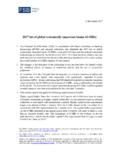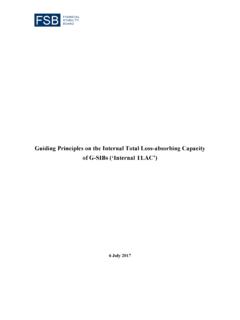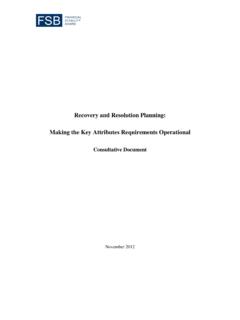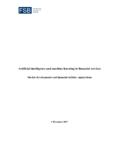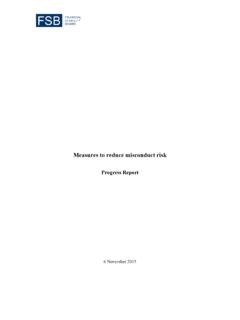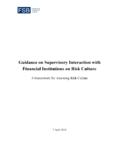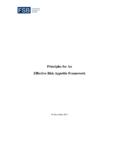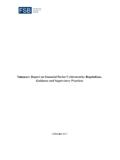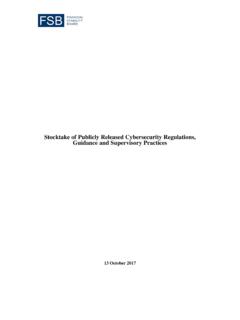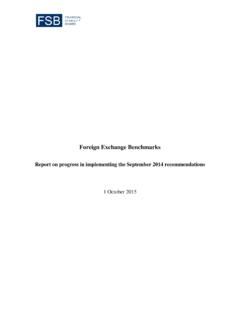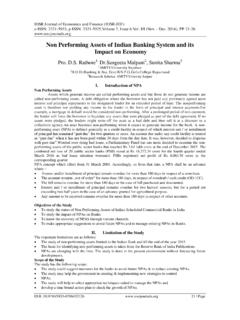Transcription of Global Shadow Banking Monitoring Report 2016
1 Global Shadow Banking Monitoring Report 2016. 10 May 2017. Contacting the Financial Stability Board Sign up for e-mail alerts: Follow the FSB on Twitter: @FinStbBoard E-mail the FSB at: Table of Contents Page Executive summary .. 1. 1. 6. Data aggregation .. 8. 2. Macro-mapping of all non-bank financial intermediation .. 10. Overview of trends .. 10. Insurance corporations and pension funds .. 13. Other financial intermediaries .. 16. Credit and lending activities .. 25. Wholesale funding and repos .. 27. 3. Interconnectedness with banks and among financial sectors .. 29. General trends in interconnectedness with banks and among financial sectors .. 31. Bank risks from interconnectedness.
2 32. OFI risks from interconnectedness .. 35. Other forms of interconnectedness among financial sectors .. 37. 4. The narrow measure of Shadow Banking .. 42. Methodological improvements .. 43. Narrowing down towards an activity-based measure of Shadow Banking .. 44. Global perspective .. 47. Cross-jurisdiction analysis .. 48. 5. The narrow measure of Shadow Banking assessment by economic 51. Economic Function 1 .. 53. Economic Function 2 .. 60. Economic Function 3 .. 62. Economic Function 4 .. 65. Economic Function 5 .. 66. Annexes Annex 1 Jurisdiction-specific summaries .. 68. Annex 2 Exclusion of OFI entity types from the narrow measure of Shadow Banking .. 71. Annex 3 Property funds in the 73.
3 Annex 4 Innovations to the measurement of the OFI residual in the UK and in Ireland .. 77. Annex 5 Liquidity in Irish MMFs and government bond funds .. 81. Annex 6 Lending-based crowdfunding in the euro area: credit provision outside of the Banking 84. Annex 7 Leveraged finance and institutional investment: recent trends and risks .. 87. Annex 8 FSB Regional Consultative Group for the Americas third Report on Shadow Banking .. 91. The Report is accompanied by the publication of a dataset on a jurisdiction and aggregate level, which also includes the data underlying most of the exhibits shown in the Report . These data are available at: Shadow Banking Monitoring Dataset 2016; and Underlying data for exhibits.
4 Executive summary Non-bank financing provides a valuable alternative to bank funding and helps support real economic activity. It is also a welcome source of diversification of credit supply from the Banking system, and provides healthy competition for banks. However, if non-bank financing is involved in bank-like activities, transforming maturity/liquidity and creating leverage like banks, it can become a source of systemic risk, both directly and through its interconnectedness with the Banking system. To monitor these risks, the Financial Stability Board (FSB) has been conducting an annual Monitoring exercise since 2011 to assess Global trends and risks in the Shadow Banking system.
5 1. This Report presents the results of the FSB's sixth annual Monitoring exercise, covering data up to end-2015 from 28 jurisdictions, representing over 80% of Global GDP and including Belgium and the Cayman Islands for the first time. 2 As in the 2015 Monitoring exercise, this Report compares the size and trends of financial sectors across jurisdictions based on sector balance sheet data. Its focus then narrows to those parts of non-bank credit intermediation that may pose financial stability risks (hereafter the narrow measure or narrow measure of Shadow Banking ). For a definition of key terms used throughout this Report , see Box 0-1. While all participating jurisdictions are covered in the macro-mapping of jurisdictions'.
6 Financial system, data from China were not received in time to complete an assessment of entities in China for the narrow measure of Shadow Banking . Improvements to Chinese data collection are currently underway in order to enable Chinese authorities to fully contribute to the 2017 Monitoring exercise. The main findings from the 2016 Monitoring exercise are as follows: 3. MUNFI MUNFI and its components all continued to grow in 2015 for 21. jurisdictions and the euro area, although at a more moderate rate compared to previous years. In contrast, while banks continued to grow in 2015, their share in the financial system declined for the fourth consecutive year, particularly in the euro area.
7 OFIs OFI assets rose from $89 trillion in 2014 to $92 trillion in 2015 in 21. jurisdictions and the euro area. Growth occurred in all but seven jurisdictions and was due, in part, to a combination of higher equity valuations and an increase in non-bank credit intermediation. The size of OFIs was equivalent to 150% of total GDP at end- 2015, exceeding the previous high-point of 139% prior to the financial crisis. OFIs grew 1 The FSB defines Shadow Banking as credit intermediation involving entities and activities (fully or partly) outside of the regular Banking system . Some authorities and market participants prefer to use other terms such as market-based finance . instead of Shadow Banking .
8 The use of the term Shadow Banking is not intended to cast a pejorative tone on this system of credit intermediation. However, the FSB uses the term Shadow Banking as this is the most commonly employed and, in particular, has been used in earlier G20 communications. 2 Depending on the context, two samples are presented in this Report . The first sample is comprised of 28 reporting jurisdictions. The second is comprised of 21 individual non-euro area jurisdictions and the euro area aggregates. For details, see Section 3 Measures of growth throughout the Report are adjusted for exchange rate effect by applying a constant end-2015 exchange rate across all years to convert data denominated in local currencies into US dollars.
9 With two new jurisdictions joining the Monitoring exercise in 2016, and China not included in the narrow measure of Shadow Banking , the results presented in this Report are not directly comparable to the 2015 Monitoring exercise. 1. quicker than GDP in most jurisdictions, particularly in emerging market economies (EMEs), but declined relative to GDP in some large advanced economies outside of the euro area. Among the subsectors of OFIs, trust companies, money market funds (MMFs), and mixed/other investment funds (other than MMFs, hedge funds, equity funds, or fixed income funds) showed the strongest growth in 2015. Key terms Box 0-1. The following Monitoring aggregates are referred to throughout the Report , with (ii) and (iii) as the main focus of analysis (see Exhibit 0-1): (i) MUNFI (or Monitoring Universe of Non-bank Financial Intermediation, also referred to as non-bank financial intermediation), is a measure of all non-bank financial intermediation, which is comprised of OFIs, insurance corporations and pension funds.
10 It provides the starting point for authorities' assessment of their non- bank financial entity types' involvement in Shadow Banking (see Section 2). (ii) OFIs (or Other Financial Intermediaries) are comprised of all financial institutions that are not classified as banks, insurance corporations, pension funds, public financial institutions, central banks, or financial auxiliaries. It can be considered as a conservative proxy or broad measure of Shadow Banking (see Section ). (iii) Narrow measure of Shadow Banking (or the narrow measure or Shadow Banking under the economic functions approach ) includes non-bank financial entity types that are considered by authorities to be involved in credit intermediation where financial stability risks from Shadow Banking may occur, based on the FSB's methodology (see Section 4 and Section 5).
